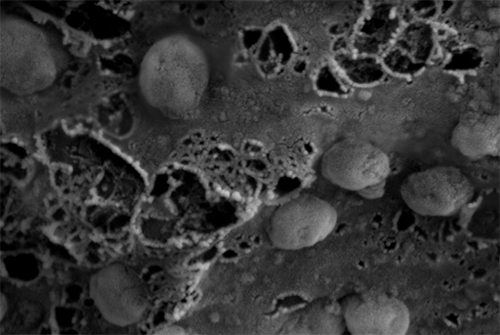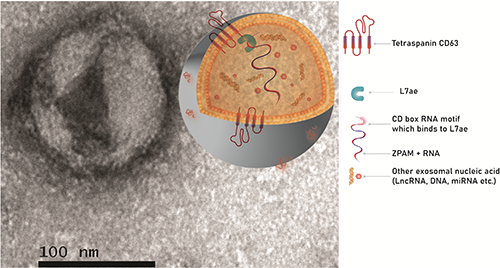Researchers Use Exosome-Based Strategy to Block HIV in Mice
NIH-funded study finds reduced levels of HIV in bone marrow, spleen, and brain after therapy
• Press Release
In a new study supported by the National Institutes of Health, researchers used exosomes, tiny nanoparticles capable of being taken up by cells, to deliver novel protein into the cells of mice infected with HIV. The protein attached to HIV’s genetic material and prevented it from replicating, resulting in reduced levels of HIV in the bone marrow, spleen, and brain. The study, funded by NIH’s National Institute of Mental Health (NIMH) and published in Nature Communications, paves the way for the development of novel delivery systems for suppressing HIV.
“These results demonstrate the potential of exosome engineering for delivering epigenetics-based therapeutics capable of silencing HIV gene expression into brain tissues — an area where HIV has traditionally been able to hide from HIV treatments,” said Jeymohan Joseph, Ph.D., chief of the HIV Neuropathogenesis, Genetics, and Therapeutics Branch within NIMH’s Division of AIDS Research.
HIV attacks the immune system by infecting a type of white blood cell in the body that is vital to fighting off infection. Without treatment, HIV can destroy these white blood cells, reducing the body’s ability to mount an immune response—eventually resulting in AIDS. Although researchers have been working to develop new therapies to treat and cure HIV and AIDS, this quest is challenging for many reasons. One reason is that HIV can enter a dormant-like state, hiding in the body and evading treatments, only to reactivate at a later date. HIV hiding in the brain is particularly difficult to access, as the blood-brain barrier often prevents treatments from entering into those tissues.
One avenue researchers have been pursuing in their efforts to try to cure HIV is what is sometimes called a “block and lock” approach, particularly for targeting HIV in the brain. This method attempts to block the virus’s ability to replicate itself and lock it in its dormant state.
Kevin Morris, Ph.D., of City of Hope and the Menzies Health Institute Queensland at Griffith University, Australia, led an investigation into a new approach for blocking and locking HIV in mice. The researchers used exosomes, tiny nanoparticles capable of being taken up by cells, to deliver a novel recombinant anti-HIV protein, called ZPAMt, into cells infected with HIV. The ZPAMt protein was designed by researchers to attach to a region of the virus called LTR that is critical for virus replication. The protein has an epigenetic marker in it that changes the way HIV’s genetic information is expressed, suppressing it, and making the virus unable to divide and multiply. The exosomes are able to cross the blood-brain barrier and enter into the brain making this treatment capable of targeting this hard-to-reach organ.
When researchers administered this exosome-based treatment to mice infected with HIV, they found that the exosome-delivered protein was capable of silencing the HIV-infected cells and that the HIV-infected mice showed suppression of HIV expression in the bone marrow, spleen, and brain.
“This exciting body of work demonstrates we can deliver therapeutic payloads to HIV-infected cells systemically using exosomes. This is an innovative technology that could be a future delivery method for use not only in HIV but also for treating various other diseases of the brain such as Parkinson’s, Alzheimer’s, and addiction,” said Dr. Morris.
Reference:
Shrivastava, S., Ray, R. M., Holguin, L., Echavarria, L., Grepo N., Scott, T. A., Burnett, J. & Morris, K. V. (2021). Exosome-mediated stable epigenetic repression of HIV-1 . Nature Communications https://doi.org/10.1038/s41467-021-25839-2
Grants:


About the National Institute of Mental Health (NIMH): The mission of the NIMH is to transform the understanding and treatment of mental illnesses through basic and clinical research, paving the way for prevention, recovery and cure. For more information, visit the NIMH website.
About the National Institutes of Health (NIH): NIH, the nation's medical research agency, includes 27 Institutes and Centers and is a component of the U.S. Department of Health and Human Services. NIH is the primary federal agency conducting and supporting basic, clinical, and translational medical research, and is investigating the causes, treatments, and cures for both common and rare diseases. For more information about NIH and its programs, visit the NIH website .
NIH…Turning Discovery Into Health®
